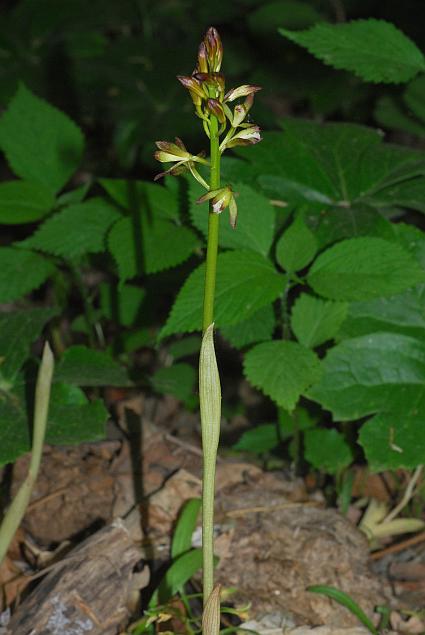Aplectrum hyemale (Muhl. ex Willd.) Nutt.
Putty Root, Adam and Eve Orchid

Native
CC = 8
CW = 0
MOC = 35
© SRTurner
Aplectrum hyemale (Muhl. ex Willd.) Nutt.Putty Root, Adam and Eve Orchid | |
 |
Native CC = 8 CW = 0 MOC = 35 |
© SRTurner |
|
Family - Orchidaceae Habit - Perennial forb, from a globose tuberous corm and roots with mycorrhizal dependency. Stem - Erect, to 60 cm.
Leaf - Basal leaf 1, petiolate, arising from youngest corm, overwintering. Basal leaf blade elliptic, glabrous, papery, slighly corrugated, dark green with conspicuous lighter colored parallel venation. Cauline leaves reduced to sheathing bracts.
Inflorescence - Terminal raceme.
Flowers - Sepals and lateral petals similar, 10-15 mm long, oblanceolate, yellow to brownish green with purple tips. Lip 10-15 mm long obovate, with 2 short lateral lobes, white with purple markings. Column 8-12 mm long, pale green with purple spots. Stamen 1.
Fruits - Pendent capsules, 1.5-2.5 cm long, elliptic in outline, strongly ribbed.
Flowering - May - June. Habitat - Rich mesic forests. Origin - Native to the U.S. Lookalikes - Broadly, species of Corallorhiza. Other info. - This is one of the more common orchids in Missouri. It has been reported predominantly from counties toward the eastern side of the state, and it also ranges throughout the northeastern U.S. The single basal leaf has a highly distinctive pinstriped and pleated appearance. These are often seen in rich forests during the winter, when they are almost the only green thing present. The leaf manufactures food for the plant throughout the winter and early spring months, enabling production of the inflorescence in mid-spring. The dried fruit stalks are also a common sight in the same areas, in late fall. Photographs taken at Faust County Park, St. Louis County, MO, mostly on 5-7-2014 (SRTurner). Photo of corm by G.Van Brunt. |